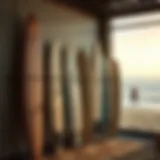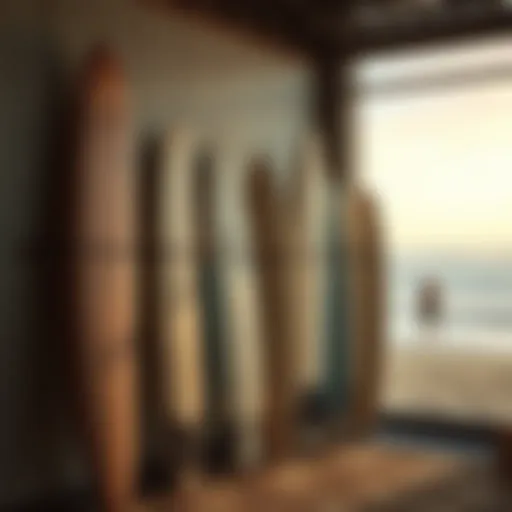Mastering Wind Direction for Better Surfing
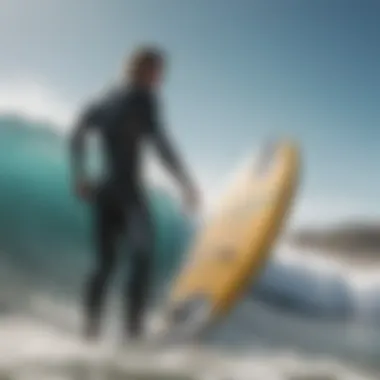

Intro
Wind plays a crucial role in shaping surf conditions, affecting not just the way waves break but also the overall experience of surfing itself. Understanding how wind direction influences these waves is key for both novice and seasoned surfers who are keen on catching the perfect ride. Factors such as wind strength, consistency, and direction can transform an ordinary surf day into an exhilarating adventure or one best spent on the shore. In this guide, we will unpack not just the science behind wind patterns, but also practical tips and techniques that surfers can employ to optimize their time in the water.
By aligning activities with favorable wind conditions, surfers can enhance their performance in the water. This article aims to provide a thorough understanding of wind direction, offering insights into how meteorological principles interact with surfing practices. Whether you're navigating the local surf break or dreaming of far-off waves, having a solid grasp of wind dynamics is a powerful tool for any surfer.
The Importance of Wind Direction in Surfing
Wind direction plays a pivotal role in shaping surf conditions. For surfers—ranging from those who ride waves casually to seasoned pros—understanding this facet can make or break their experience on the water. The reason is simple: the interplay between wind and waves influences everything from wave height and quality to the overall safety of the surf session.
How Wind Shapes Surf Conditions
The wind can position itself as a creative artist, sculpting the ocean's surface. As it blows over the water, it generates friction, which in turn creates waves. The size and shape of these waves are significantly affected by the wind's direction.
- Onshore winds, those blowing from the sea to the land, can make for chaotic and choppy conditions. These winds tend to break down waves before they can fully form, leading to a less desirable surfing experience.
- Offshore winds, on the other hand, blow from land towards the sea. This type of wind is generally favorable, as it can smooth out the surface and allow waves to crest beautifully, creating cleaner and more enjoyable conditions for surfers.
For instance, if you’re trying to catch waves at Malibu Beach, an offshore breeze from the east can make a world of difference, molding those famous swells into perfectly rideable waves.
Balancing Wind and Wave Quality
Finding a balance between wind and wave quality isn't just a matter of luck; it demands a keen understanding of natural dynamics. Each surfing locale is unique, with its wind patterns and tidal influences that can drastically change in a matter of hours. When assessing conditions, surfers must consider the following:
- Timing: It's crucial to evaluate how the wind has shifted throughout the day. In many cases, morning hours can offer optimal conditions with glassy waves before wind picks up in the afternoon.
- Local Knowledge: Recognizing how the local geography can affect wind patterns is indispensable. Points, bays, and reefs can alter the wind's impact, leading to microclimates.
- Swell Direction: It’s not just about the wind; the direction of the swell also needs consideration. The best waves come when the swell direction aligns with the wind direction, providing a harmonious dynamic that maximizes quality.
To truly excel at surfing, one must learn to read the signs that nature presents. As the saying goes, the ocean has its own rhythm; understanding and harmonizing with that rhythm can elevate any surfer’s performance.
Fundamentals of Wind Dynamics
Understanding wind dynamics is like peeling an onion; it has many layers, each influencing surfing conditions in unique ways. Wind doesn’t just blow; it shapes the ocean’s surface and, consequently, the waves we ride. For surfers, recognizing these fundamental dynamics can turn a mediocre surfing day into an exhilarating experience.
Understanding Weather Patterns
To begin with, weather patterns significantly dictate wind behavior. The Earth’s atmosphere is a dance of high and low-pressure systems. When a high-pressure area meets a low-pressure zone, wind is born, usually flowing from high to low.
- Seasonal Changes: Different seasons bring varied wind patterns. For instance, summer generally sees lighter winds, while winter often brings more powerful gusts. This could affect both waves and comfort while surfing.
- Frontal Systems: Cold fronts can lead to increased wind speed, which might create challenging surf conditions. Identifying whether a front is passing through can help surfers decide whether to hit the waves or stay on land.
Utilizing weather forecasts effectively can help surfers anticipate these changes. Sources like NOAA or local surf reports can provide invaluable insight into upcoming conditions, avoiding the heartache of arriving at the beach only to find flat water or overpowering winds.
The Role of Local Geography
While the winds themselves are vital, geography plays a crucial part in amplifying or diminishing their effects. Coastal configurations can redirect and modify wind flow.
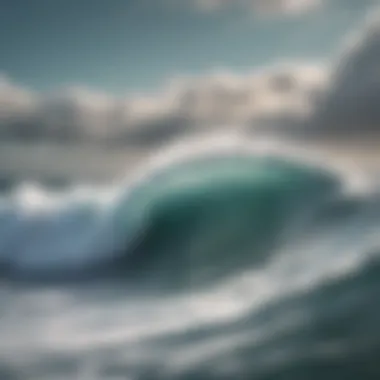

Take, for instance, the famous surf spot around Hookipa Beach in Hawaii. Its shape creates a funneling effect that intensifies the wind waves, making them a favorite for seasoned surfers.
- Land Forms: Cliffs, beaches, and inlets can alter wind patterns. Cliffs often act as barriers that redirect airflow.
- Ocean Floor Topography: The underwater landscape can also affect how waves break. A shelf that rises steeply can lead to more powerful, choppy waves.
In summary, understanding these geographical influences can help surfers determine the best locations to catch waves based on current wind conditions. By applying this knowledge, surfers can select spots that align with prevailing weather patterns, increasing their chances of enjoying favorable surfing experiences.
"Navigating the complexities of wind dynamics is not only about knowing where to surf but also understanding when to surf. News travels fast in the surfing community, but the savvy surfer knows that preparation and awareness can make all the difference."
Ultimately, grasping the fundamentals of wind dynamics paves the way for better decision-making on the water. Whether a seasoned pro or an enthusiastic beginner, knowledge is a surfboard that allows every rider to catch the perfect wave.
Techniques to Determine Wind Direction
Determining wind direction is a fundamental skill for surfers, as it significantly affects wave quality and overall surfing experience. As the wind blows across the ocean, it shapes the waves and can make or break a good surf day. Therefore, understanding the techniques and tools available for gauging wind conditions can be the difference between a lackluster session and an exhilarating ride.
Using Weather Apps Effectively
In today’s digital age, weather apps have become indispensable for surfers seeking optimal conditions. These applications provide real-time data on wind speed and direction, among other variables. When selecting a weather app, look for ones that offer detailed surf forecasts with wind statistics. Some popular options include Windy and Surfline, which give you a clear view of what the wind’s doing in a particular area.
To get the most out of these tools, paying attention to the wind arrows displayed on the maps is crucial. Not only do they indicate direction but also the intensity of the wind. Strong gusts incoming from the ocean can disrupt wave patterns. As a pro tip, check the app multiple times leading up to your surfing session, as wind conditions can change quickly.
"Staying ahead of the game means keeping an eye on the forecast, so you’re not caught in a pickle remember?"
Observing Natural Indicators
Sometimes, technology can’t beat a bit of old-fashioned observation. As you head to your favorite surf spot, take a moment to analyze the environment around you. Here are some natural indicators to consider when determining wind direction:
- Trees and Vegetation: Trees often sway toward the direction from which the wind blows. Look for clues in their movement.
- Ocean Surface: Notice the surface of the water. Choppy waves often indicate stronger winds, while smooth surfaces can signify calmer conditions.
- Sea Birds: Birds flying with the wind can point you toward prevailing wind patterns, while those struggling against it are indications of strong gusts.
These indicators, while less precise than technology, can provide valuable insights when combined with your prior knowledge of local surf conditions.
Wind Vane Devices: An Overview
Wind vanes offer another practical approach for determining wind direction. These devices are simple to set up and can be used on beaches or even tied to your surfboard if you’re feeling adventurous. They consist of a rotating arm that shows the direction from which the wind is coming.
While the initial cost of a good wind vane may seem high, especially for novice surfers, it can be a worthwhile investment for those serious about improving their surf sessions. Not only do they provide real-time information, but they also help develop your instinctive understanding of how wind conditions shift.
Impact of Wind on Wave Formation
Understanding the wind's role in wave formation is crucial for surfers looking to make the most of their time on the water. The wind doesn't just stir the surface of the ocean; it is a fundamental force that contributes significantly to the creation and shape of waves. Riders must grasp how wind influences wave characteristics like height, shape, and strength to identify optimal surfing conditions.
The interaction between wind and waves is not merely incidental. Wind speed and direction dictate wave development and can create varying experiences at the same surf break on different days. A consistent onshore breeze, for example, can transform clean, hollow waves into choppy, disorganized swells. In contrast, offshore winds can sculpt perfectly formed waves, enhancing the surfing experience.
Key Elements Impacted by Wind:
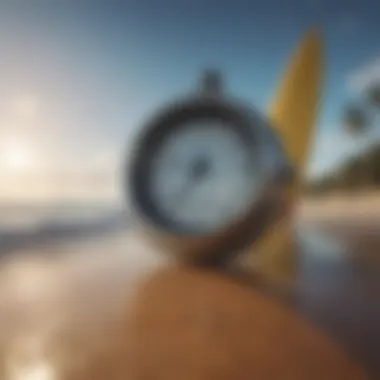

- Wave Energy: Strong winds can generate larger swells, while lighter winds may produce smaller, more manageable waves.
- Wave Shape: Winds can influence whether waves break on the left, right, or across. The angle of the winds also determines how waves stack up before breaking, affecting the ride quality.
- Consistency: Wind patterns play a vital role in creating stable surf conditions. A solid offshore wind can maintain a clean line, essential for good surfing.
Considering these aspects can drastically improve how surfers select their time on the water, making it an essential focus of any serious surf enthusiast.
The Science Behind Wave Development
Diving into the specifics, the science behind wave development is rooted in physics and fluid dynamics. Wind acts on the water's surface, transferring energy and initiating wave formation. As wind travels across the surface, it creates friction with the water, leading to the formation of ripples. These ripples develop into waves as the wind continues to exert force. Factors such as wind duration, speed, and fetch—the distance over water that the wind blows—are crucial.
- Fetch: A longer fetch allows waves to build up energy and size more efficiently. For instance, waves that travel thousands of miles across the Pacific Ocean will typically be larger and more powerful than those originating from a short fetch.
- Duration and Speed: The longer the wind blows at a consistent speed, the bigger the waves can get. A gusty wind that varies in intensity tends to produce erratic wave patterns.
From a biological standpoint, there's also an important connection between wind-generated waves and their impact on marine ecosystems. While surfers ride these waves, the wind-driven currents help distribute nutrients in the ocean, sustaining a diverse marine life.
Identifying Optimal Conditions
To maximize your surfing experience, recognizing optimal wind conditions is key. Identifying the ideal wave conditions often involves analyzing the wind along with other factors, such as tide and local weather patterns. Here are some practical considerations:
- Wind Direction: A general rule of thumb is that offshore winds (blowing from the land towards the sea) are ideal for clean wave formation. Conversely, onshore winds (blowing from the sea towards the land) can wreak havoc on surf conditions. Understanding local wind effects helps in predicting the best time to surf.
- Time of Day: Early mornings often present more favorable wind conditions. As the day progresses, land heats up, causing thermal winds that can disrupt wave formation. Observing this trend can leverage early sessions to your advantage.
- Checking Local Reports: Before heading out, it's wise to check local surf reports and forecasts. Websites and apps that provide wind data give surfers insights into what conditions to expect. Some resources also offer real-time updates about wind and wave conditions.
"The right wind direction can transform an average day into a memorable ride; knowledge is a surfer's best tool."
Adapting Surfing Techniques to Wind Direction
The rolling waves are not just a product of the ocean’s whims. Wind plays a crucial role in shaping surf conditions. Understanding how to adapt your surfing techniques according to wind direction isn’t just a nice-to-have—it’s a necessity for anyone serious about riding the waves. Mastering this skill can mean the difference between slicing through perfect curls or struggling to stay upright in choppy waters.
Choosing the Right Spot Based on Wind
Selecting a surf spot based on wind direction is like picking your battle in a chess game; it sets the tone for the entire session. Something as simple as an offshore breeze can create optimal conditions, allowing the waves to build up without interference from the wind. On the other hand, an onshore wind can flatten out waves, leading to less enjoyable rides.
Here are some key factors to consider when choosing a surf spot:
- Offshore Winds: These winds generally carry air from land to sea. They tend to groom the waves, making them more consistent and well-formed. Beaches exposed to these winds, like Malibu in California, often yield high-quality waves.
- Onshore Winds: Winds that blow from the ocean to the shore can create choppy waves that are less favorable for surfing. For example, in places like Huntington Beach, surfers choose to go out at times when the onshore winds are minimal.
- Side-shore Winds: These winds blow parallel to the shoreline and can provide a mixed bag. Depending on the alignment of the waves and wind, it can lead to interesting conditions, but it’s also necessary to have a well-developed skill set to handle them effectively.
A good practice is to use weather apps that specify the wind direction and conditions. Many of these apps allow you to track patterns over time, helping you learn the best times to surf specific breaks.
Adjusting Surfboard Selection
Your choice of surfboard significantly affects how well you can adapt to varying wind conditions. Not every board will perform the same when the wind shifts, and understanding surfboard nuances can bring about pronounced improvements in your surfing experience.
Things to keep in mind when selecting your surfboard based on wind conditions:
- Board Length: A longer board may provide more stability in choppy conditions, but it could also be harder to maneuver in bigger surf that has strong winds.
- Board Type: Shortboards are great for agility but can struggle if the wind is onshore due to being more susceptible to being pushed around. Longboards, on the other hand, offer stability and can glide smoothly on flattened out waves, making them more favorable in those windy situations.
- Tail Shape: Boards with a squarer tail can produce more drive and hold well in less ideal conditions, whereas rounder tail shapes may be better suited for speed in cleaner conditions.
Ultimately, your board choice should complement not just your skill level, but also the wind conditions on that day. Understanding these variables puts you in the driver’s seat, ensuring you’re always ready to catch a wave.
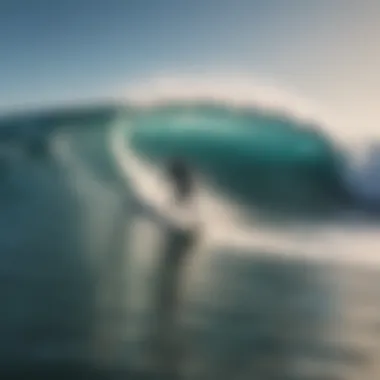

"Wind direction isn’t just a detail; it’s the headline act in your surfing experience. Adapt and thrive, or ignore and struggle."
By paying attention to wind direction and understanding your gear, you equip yourself to make the most of your time in the water. Whether you’re a seasoned pro or a casual surfer, adapting your techniques to meet the demands of the wind will enrich your surfing experience.
Case Studies: Surf Breaks and Wind Patterns
Understanding how wind interacts with specific surf breaks offers surfers critical insights into optimizing their sessions. Different surf spots exhibit unique behaviors based on local wind conditions and topography. By analyzing these case studies, surfers can glean valuable lessons that enhance their decision-making skills when selecting when and where to surf.
Famous Surf Spots Reviewed
- Pipeline, Oahu
The infamous Pipeline, famed for its massive waves, showcases how local wind patterns shape surf quality. When the trade winds blow consistently from the northeast, they smooth out the surface, leading to clean, rides. However, during summer, a south swell coincides with offshores, creating conditions that only advanced surfers should tackle. - Mavericks, California
Known for its powerful waves and cold waters, Mavericks' optimal conditions occur during winter months when strong north winds blow offshore. A combo of swell direction and local winds can create jaws-dropping tubes. Surfers need to pay attention to wind conditions, as a sudden shift can turn a good session into a challenging experience. - Bondi Beach, Australia
At Bondi, the predominant easterly winds produce ideal surf during summer months. The beach break benefits from consistent swells and local wind patterns that create manageable waves. Surfers tend to look for mornings where the winds are calm, resulting in cleaner surfaces and exciting rides. - Jaws (Peahi), Maui
Jaws is renowned for its size and intensity. When the waves are three times overhead, the shifting wind determines whether conditions remain favorable. The local northeast winds blow towards the beach, which leads to waves breaking at the right angle, enticing the bravest of surfers. However, a strong south wind can lead to choppy surfaces, making it treacherous even for professionals.
Lessons from Professional Surfers
Professional surfers often emphasize the significance of tuning into local wind patterns as part of their preparation. One common lesson is:
- Know the timing: Many pros know that the best time to surf is often early in the morning when offshore winds prevail.
- Adaptive strategies: Elite surfers adjust their tactics based on wind changes. For instance, some will choose maneuverability over stability if the wind turns onshore.
- Observation matters: Surfers continually observe wind patterns, not just the waves. Experienced surfers often use their keen insight, like assessing trees and flags to gauge wind strength and direction.
"There's no perfect wave without the right wind"
— Legendary surfer Kelly Slater
Surfers who succeed in extracting these insights boost their chances for a valuable experience on the water. Ultimately, specific surf spots and their unique cases provide tangible evidence of the wind's critical role in surfing conditions.
Predictions and Future Trends
Understanding how wind direction interacts with surfing conditions goes beyond just current knowledge; it's essential to keep an eye on future trends as well. The changing tides of technology and weather patterns can significantly impact surfers' experiences. As such, adapting to these shifts is crucial for anyone looking to make the most of their time on the water.
One major aspect of this dynamic is the continuous advancement in weather forecasting technology. This enhances surfers’ ability to predict optimal conditions well ahead of time. Accurate forecasting becomes even more critical, especially for surfboarders who plan their adventures around specific swell and wind parameters. Knowing what to expect can mean the difference between riding perfect waves or fighting against unfavorable winds.
Furthermore, understanding the implications of climate change can't be overlooked. The way wind patterns have shifted due to global warming poses real challenges for surfers and the environments in which they thrive. Sea levels rise, creating new coastal setups and shifting existing surf breaks, possibly rendering once-popular spots irrelevant. Surfers must prioritize awareness of these factors, adapting their strategies to align with evolving patterns.
Emerging Technologies in Weather Forecasting
The proliferation of modern forecasting tools has entirely transformed how surfers gather data about wind direction. Online platforms and applications like Windy, Magicseaweed, or Surfline provide detailed insights that go beyond the basic weather report. They offer animated wind maps, swell predictions, and even live updates on conditions, making it easier for surfers to plan trips effectively.
These tools utilize complex algorithms that analyze a multitude of data points—from satellite images to real-time buoy readings. With just a few clicks, surfers can access a wealth of information that was previously reserved for meteorologists. Having access to such technology allows a surfer to make educated decisions based on real conditions rather than relying on guesswork.
High-resolution models are becoming more accurate, leading to longer prediction windows. For instance, predictions on wind and wave heights used to be reliable for about 24-48 hours. Now, with advancements, surfers can receive forecasts that are dependable up to a week in advance.
Implications of Climate Change on Wind Patterns
Climate change is reshaping natural elements in more ways than can be easily seen. Among these transformations, wind patterns are shifting considerably, making it vital for surfers to understand the long-term repercussions. Changes in atmospheric temperatures are affecting local weather, leading to more volatile conditions.
In many regions, this fluctuation can mean a decrease in predictable wind patterns that surfers have come to depend on. Tides will change, swells may become less frequent or perhaps more intense, and even the seasonal wind shifts are becoming less reliable. This unpredictability can lead to confusion, as what once was a surfer's paradise might turn into a tangled mess of choppy waves and inconsistent breaks.
Surfers should also consider the geography of their favorite surf spots as these areas may evolve due to coastal erosion or even gain new landforms due to increased sediment deposition. Embracing flexibility will be key to adapting to such changes. Taking cognizance of patterns over the years and maintaining a proactive approach will ensure surfers stay ahead of the game.
"Looking at the future isn't just about predictions; it’s about being prepared for the unknown as we surf through uncertainties."
Overall, keeping a finger on the pulse of these trends can empower surfers to navigate through the turbulent waters of change. By combining new technologies with an understanding of how climate impacts wind patterns, surfers can continue to optimize their experiences and find joy amidst the waves.












